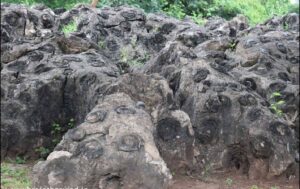GS1 – Art & Culture

Context
Salkhan Fossil Park, also known as Sonbhadra Fossils Park, located in Sonbhadra district of Uttar Pradesh, qualifies as a geo-heritage site under the IUCN’s 2020 guidelines on the “Evolution of Life” and aligns with UNESCO’s 2021 framework on Earth’s history and life’s origins.
Location:
Situated near the Kaimur Wildlife Sanctuary in the Kaimur Range, which forms part of the Vindhya mountain system.
Key Features:
- Hosts some of the world’s oldest and best-preserved fossils, estimated to be around 1.4 billion years old.
- Fossils primarily include Stromatolites, formed by Cyanobacteria (blue-green algae), which are indicative of early microbial life.
- These structures provide evidence of the Great Oxidation Event, a period when oxygen began accumulating in Earth’s atmosphere.
Scientific Significance:
- Stromatolite variations reflect ancient aquatic and sedimentary conditions, offering vital clues about early Earth environments.
- Helps bridge the Precambrian gap in the fossil record, representing nearly 85% of Earth’s geological history.
- A globally significant natural archive for understanding early evolution and supporting scientific research and conservation efforts.
UNESCO World Heritage Sites – Background:
- Recognised under the World Heritage Convention for their “Outstanding Universal Value.”
- Aim to protect sites of cultural, historical, scientific, or natural importance.
- Classified into three categories: Cultural, Natural, and Mixed Heritage.




